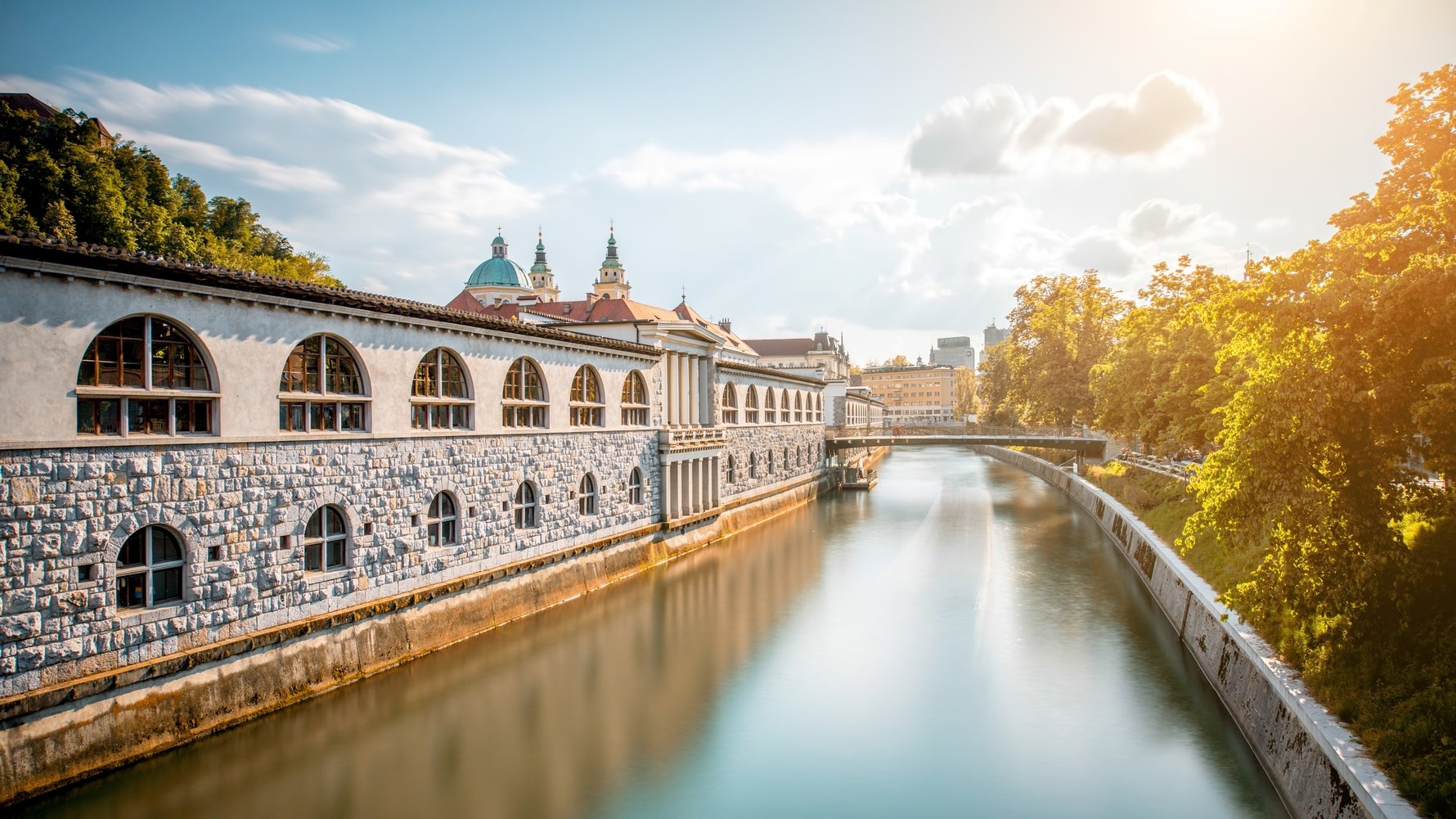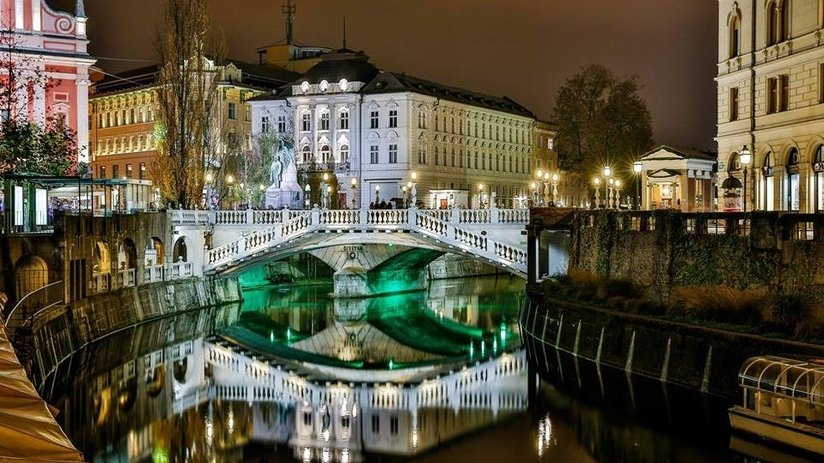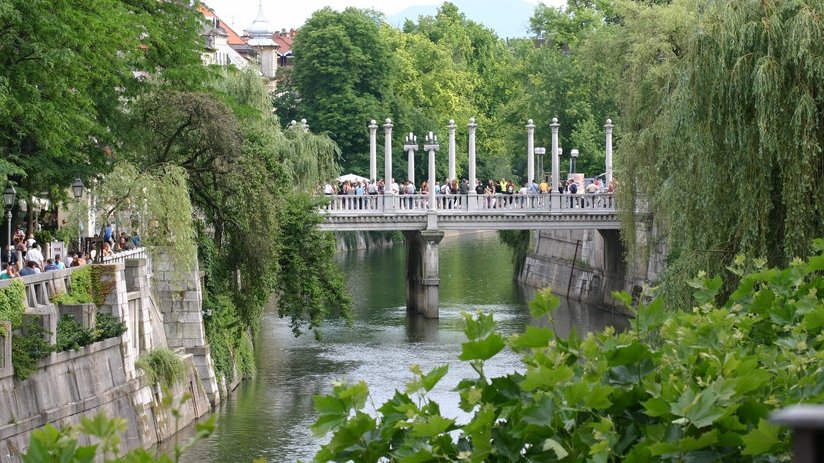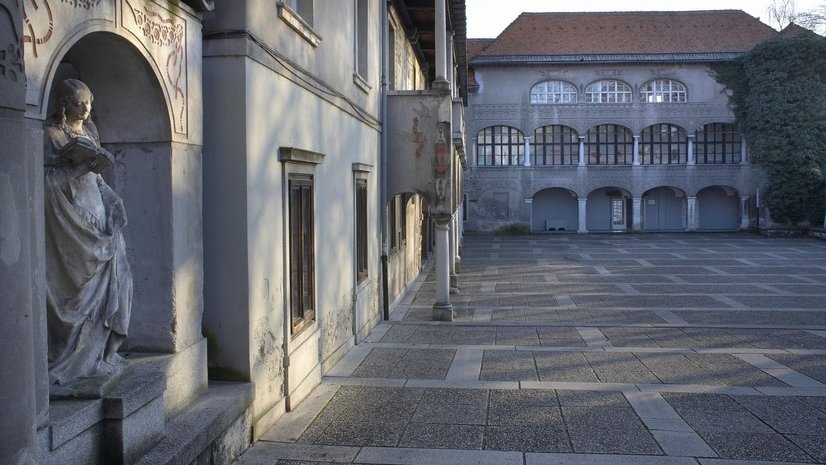Go there and take your pictures, then look at Plečnik’s arcades and market, from either side of the river. If you go on the right bank - the same side as the castle - you can stroll along the arcades and admire this work on a more human scale. Plečnik intended it as a monument to Emona, Roman Ljubljana, which explains the simple classicism of the columns and colonnades.

One oddity to note, the columns at the end nearest Dragon Bridge are longer than those by Triple Bridge, and were designed this way to reduce the effects of perspective when looking from the latter, an illusion that can be slightly unsettling when seen from either end. The arcades are now occupied by cafés, delicatessens and butchers. Near the Triple Bridge end there also a downstairs fish market that overlooks the river, and is worth visiting if only to see how form did not overwhelm function in this building.
Turning away from the arcades you have the market itself, which Plečnik designed with both open and covered areas. The latter has some interesting stalls selling meats, cheeses, dried fruits, nuts and other specialties. The open market remains an important part of the city centre, where local families and businesses shop for supplies, and it’s well worth visiting in the mornings.
While walking through the arcades and market can let you see Plečnik’s work close-up, a very good view can be had from the other side of the river. There’s a short and very pleasant walk along Petkovškovo nabrežje, which lets you see the arcades as a whole, revealing how they follow the line of the mediaeval wall that encircled the old town. You should also note the uneven stone blocks in the wall, something Plečnik made use of in other places on this walk, as well as the turret-like structure that covers the spiral staircase to the fish market. There’s a run of excellent cafes and bars, so you’re sure to find somewhere you like to sit down, relax, and enjoy the view.

While Plečnik made plans for a bridge connecting both side of town here, the existing Butchers’ Bridge was only built at this site in 2010, and is perhaps best-known as the one covered in so-called lover’s locks. We’ll leave the utility of this for you to consider, but it’s a good bridge to visit, both for the interesting and often amusing sculptures that it includes, and the views it provides of the next Plečnik structure on this walk, the Triple Bridge.
On a fine day when Prešeren Square and the Triple Bridge are full of people walking to and fro it may seem like this place has been unchanged for centuries, so well does it blend into the old town, but in fact the area was only pedestrianised in 2007. Until then vehicles went through the square and over the main bridge, as they had done since mediaeval times. This reveals one of Ljubljana’s secrets, one underlined by Plečnik’s creations - its ability to grow more beautiful over time, by reworking the past rather than erasing it.
The Triple Bridge is another good example of this. The 19th century stone bridge crossing the Ljubljanica eventually became too small for the amount of traffic it carried, and the new structure was Plečnik’s solution. The outer bridges were built for pedestrians, while the middle one was reserved for vehicles. A noted feature is the use of balustrades, 648 in total, and it’s worth looking out for echoes of these in other Plečnik buildings around town, as he was a great believer in recycling and reusing materials.

The Triple Bridge can be enjoyed from many angles, and we recommend you approach it from various sides during your stay, perhaps even by boat, to enjoy the spaces it opens up as it connects the old and new parts of Ljubljana. Our favourite view, however, comes a little further down the river, from the next, rather unassuming bridge. To get there you can walk along Cankarjevo nabrežje, past Lolita and other riverside cafés and bars, or, to continue the Plečnik theme, walk along the side opposite the castle.
The next Plečnik structure on this side of the river is the back-end of the Slovenian Philharmonic Concert Hall, which he designed with a rippled appearance to mimic the waves on the Ljubljanica. Now occupied by the Solist lounge bar, the structure is a good example of the playfulness the architect was capable of, as well as his sensitivity to the environment, both natural and built. Right next to the Philharmonic is a staircase that Plečnik also designed, and if you’ve been paying attention then you might be able to spot it – it’s the one with a column.
From whatever side of the river you approach it from, Cobbler’s Bridge is our favourite in town. It’s a striking work, with columns running along each side, and can look especially beautiful at night. In mediaeval times it was known as Butcher’s Bridge, but the smell was so unpleasant those tradesmen were asked to leave and shoemakers took their place. Floods and fires then meant numerous changes over the years, with Plečnik’s work finally taking shape in 1931.

From here you can go deeper into the old town, walk along the river into Breg, or head off to the library and Križanke, the last two of Plečnik’s monumental works in the city centre. On this walk we’ll assume you keep walking away from the centre of town, stopping at New Square (Novi trg), the one with a fountain, and then heading up to the large, square building you’ll see after the end of the square on the left, with a grey base of uneven stones, red brick middle section and flat roof. You’ll need to walk along Turjaška ulica, passed the side of the building, and then turn left on Vegova ulica.
From the outside the National and University Library can seem a little underwhelming, especially compared to the nearby University of Ljubljana building, formerly the Provincial Mansion, which can see by turning left on Vegova. This faces Congress Square (Kongreski trg) and runs for a whole block, with different designs on each façade.
While at first glance the library may look like a rather dull box, look closer and you should be able to see a number of elements that mark this as a Plečnik building. These include the three distinct levels to the outer walls, and the mix of quarried stones with red bricks and blocks recycled from older buildings, as well as the column in the middle of the reading room windows. It is inside, though, that the work reveals itself, as Plečnik designed many of the details, from the horse-head door handle to much of the original furniture and fittings. The main staircase and reading room are especially impressive, and there are regular tours of the building for visitors.

Nearby you’ll see a tall column in another small square, called French Revolution Square (Trg Francoske Revolucije), and this is Plečnik’s Napoleon Obelisk. There are some good cafés here, so it's an excellent place to rest your feet, get a drink and enjoy the view. You’re not far from the City Museum or the last Plečnik building on this walk, Križanke.
Križanke was Plečnik’s final major work in Ljubljana, and makes a fitting end for this short journey through some his notable structures. For this project he was tasked with turning an old monastery into a summer theatre. The complex is a fascinating mix of elements from different eras, giving the space it’s timeless feel, and it’s hard to imagine it was only finished in 1956.
Plečnik made use of items from older buildings in the city, recycling statues, window frames and other features, and as you look around you should see much to remind you of the other works seen on this walk. The space is open to visitors and often hosts concerts, the architecture providing a magical setting in which to experience the right performance under the stars.
Text by Paul Steed





Comments